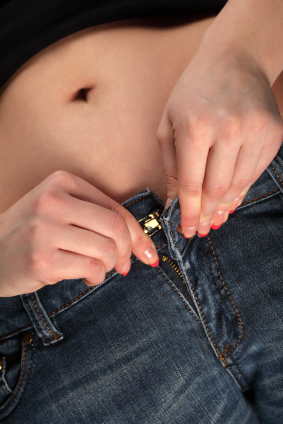Battle of the midlife bulge: diet+gender=
I am on a roll! On a roll around my midsection, that is.
Ever wonder why women may be likelier than men to gain fat in their abdominal area, especially as they go through menopause? Yup, we’ve talked lots on Flashfree about estrogen, exercise and even stress and the release of cortisol and how they affect that growing tummy donut. However, researchers are now adding another factor into the mix that may occur especially in women: a high-fat diet. Mind you, this particular study, which is published online in Diabetes journal, was conducted in mice so it’s way too early to comment on how the findings affect actual humans. But what it does imply is that diet might not be the only factor at play and in women, genetics and gender play an equally important role.
Researchers say that when female mice were fed a high fat diet, it triggered the production of an enzyme (called aldehyde dehydrogenase 1) that produce a hormone — retinoic acid — that boosts the formation of fat around the abdomen. Let’s step back; high fat diet leads to enzyme, leads to retinoic acid leads to belly fat. Got it?
Interestingly, not only is this enzyme activated at nine times the level in female versus male mice, but when removed, this domino effect disappears. What’s more? Estrogen can suppress the enzyme so when it starts to decline, women become more prone to developing that midsection bulge.
The culprit here is vitamin A and how the female body processes it. One of the functions of vitamin A is to produce a molecule that supports how the body burns both fat for energy and retinoic acid. Evidently, high fat diets can directly shut down the fat burning molecule and the domino effect begins, resulting in the midlife bulge many of us have come to know so well.
The good news is that on a regular diet, female mice barely produced retinoic acid, meaning the simple solution for women may be to stay away from high fat meals as much as possible.
If you can’t burn it, and you can’t rely on estrogen to keep the fire going (or take it away -ironic, right?!), then take some steps and do it yourself. D is for diet. F is for female. The endgoal? Do the math.
Read MoreBattle of the middle-aged bulge: pick your poison
That age old battle of the bulge just got more challenging.. Researchers are saying that middle-aged women who store fat around their mid section are twice as likely as their peers to develop dementia in old age. Yikes! More reason than ever to lose that belly fat, right?
Starting in 1960, researchers looked healthy and lifestyle risk factors in 1,462 women and then at various intervals for 32 years. They found that women who were broader around the waist than the hips by the time they reached middle-aged more than twice the odds of developing dementia if they lived beyond 70 years. However, a higher body-mass index did not infer a similar risk.
Whether it’s associated with aging, testosterone or declining physical activity, weight gain around the midsection has been linked with the metabolic syndrome, which increases your risk for heart attack and stroke.
So, we’re left with a choice – heart attack, stroke or losing our minds….Or, better yet, move your body. Exercise, start eating healthier and being more mindful of what’s going in and what you are putting out. Granted, we may not be able to fight the inevitable but we can at least try to stave it off or control it as much as possible. The bulge around the middle is the hardest area to attack. But it’s not impossible.
I’d love to get some fitness experts to weigh in on this. Anyone?
Read MoreBattle of the bulge

You know that donut that’s forming around your midsection? The one that doesn’t seem to budge even though you’ve boosted your exercise regimen and take a restrained approach to eating whenever possible? The one that some experts say has nothing to do with hormones and others say it does?
New data from the Study of Women’s Health Across the Nation, which I’ve referenced previously in many posts, suggest that testosterone might be the culprit here. In this particular analysis, researchers examined the potential relationship between testosterone and visceral (belly) fat in 359 middle-aged women who were in various stages of the menopause. Visceral fat was measured via CT scans, and blood was drawn to assess sex hormone (i.e. estrogen and testosterone) levels.
Study findings, which were published in the online edition of Obesity, showed that levels of active testosterone were the strongest predictors of the development of the middle-aged bulge, even more so than estrogen. What’s more, this association remained even after the researchers made adjustments for total body fat, age, race and other risk factors.
Besides appearance, abdominal fat is linked with an increased risk for the metabolic syndrome, a collection of risk factors that in concert, promote coronary heart disease. What’s more, circulating levels of testosterone may increase one’s risk for developing the metabolic syndrome.
It’s challenging. We’re told to exercise more, restrain our eating, limit alcohol intake and yet, there’s still no magic bullet to kill the middle -age bulge, especially since the battle may ultimately lie with hormonal balance. But don’t lose hope; I suspect that before many of us are through the worst of it, researchers may finally identify a viable, effective strategy.
In the meantime, don’t give up. I’m not sure that all is lost. At least, I hope not!
Read MoreStress eating? Spare Tummy Tire? Try a little mindfulness…
Mindfulness. It keeps popping up in different areas of health. Last time I posted about mindfulness training, it was within the context of hot flashes and how training your mind to reduce stress can influence how hot flashes are experienced. But what about stress eating?
Many women (and men) turn to emotional eating when they are stressed. And unfortunately, when it comes to weight gain, many of the most serious health affects of excess weight tend to be linked to that roll around the tummy area. In fact, abdominal (or visceral) obesity produces inflammation in the body that can increase the risk for diabetes and heart disease. In women in particular, who may be prone to weight gain in their abdominal area due in part to hormone fluctuations, it’s a double-edged sword. Add the fact that chronic stress increases levels of cortisol, which in turn, mobilizes the migration of fat cells to the midsection, and well, it’s a disaster in the waiting.
As I have written previously, cortisol is a hormone that is secreted by the adrenal glands. Its primary role in the body is to regulate energy (by producing blood sugar or metabolizing carbohydrates, protein and fats) and mobilize it to areas where is it most needed so, cortisol levels tend to peak in the early morning and then gradually decline throughout the day. Research has shown, however, that women have higher cortisol levels than men, and that certain women –especially those with greater amounts of abdominal fat — may be reacting to a large disruption in the release of cortisol that causes a greater than normal difference between morning and evening levels of the hormone. This disruption is believed to be related, at least in part, to exposure to prolonged physical and mental stress. This psychological component is huge, because it tends to trigger the desire to consumption of food that is high in fat and/or sugar, which also tends to promote abdominal weight gain.
How do you break the cycle?
Researchers are now saying that mindfulness may be an important strategy to beat the bulge and the stress. In fact, whey they looked at the effects of a program that focused on interrupting habitual thoughts, emotions and behaviors, that is exactly what they found.
In this small exercise, 24 overweight and obese women not yet in menopause learned to use guided meditation as a way to introduce mindful eating (i.e. paying attention to their physical sensations of hunger, stomach fullness, taste satisfaction and food cravings). They were also taught to be more aware of emotional eating triggers and negative emotions as well as to be more loving and accepting of both themselves. Over nine weeks, they were able to share their challenges, concerns and experiences and then learned new meditations to overcome what they felt were roadblocks in their progress. During the same four week period, 23 women were placed on a waiting list for comparison purposes.
Regularly engaging in mindfulness training set these women off on the right foot upon awakening and in fact, lowered their cortisol levels in the early am hours. What’s more, women who reported having the greatest improvements in their response to stress and emotional eating triggers tended to have the largest reductions in abdominal fat. Additionally, reductions in waking cortisol levels were related to reductions in abdominal fat as well.
Mind you, the women in this particular study were premenopausal, namely because the researchers say that hormonal declines naturally lead to deposits of fat in the midsection. However, if psychological stress compounds weight gain in this area as much as it affects overall wellbeing and menopausal symptoms, it might be worthwhile considering if incorporating ‘a little mindfulness’ into one’s life could help shift fat away from the abdomen as well. It’s an interesting idea and definitely worth exploring…especially as we move into what many regard to be the most stressful and eating laden season of the year: the holidays!
Try a little mindfulness. Not only can it benefit your brain but your tummy might reap the benefits as well.
Read MoreIt’s not weight gain! It’s a shapeshifter!
[Copyright: Doug Savage. Many thanks for use of this cartoon. Who doesn’t love a chicken?! Show some love… www.savagechickens.com]
In literature, shapeshifting takes place when an individual finds her figure involuntarily changed by someone or something else, menopause for example! For women in midlife in particular, weight gain often becomes a primary concern. But it’s not just any weight gain — it’s the spare tire in the midsection, the sudden belly that seems to appear out of nowhere, that causes the most distress.
If you go back through the archives on weight gain during menopause, you’ll discover that the midsection bulge is a personal pet peeve. And while research has shown the mindful meditation, getting up from your chair during the workday, biking and perhaps even isoflavones may make a difference, a recent review in Climacteric journal goes one step further towards clarifying the ‘why.’
The findings may interest you. For example, weight gain itself does not appear to be affected by hormonal changes during menopause. “It’s a myth that menopause causes women to gain weight” says the leading review author Professor Susan Davis from Monash University. Rather, she says that “it’s really just a consequence of environmental factors and aging,” (i.e. absolute weight gain as we age is influenced by non-hormonal factors, such as low activity levels, previous pregnancies, family history of obesity and even the use of certain antidepressants or having undergone chemotherapy). However, hormones — namely the fall in estrogen — cause the fat to deposit itself in the belly (oh, joy!). In fact, data suggest that during perimenopause, there is a rapid increase in fat mass and redistribution of this fat to the abdominal area, leading to an increase in total body fat.
Whether or not you call it weight gain or shapshifting, the result of this excess weight goes well beyond physical appearance and self esteem. We know that excess weight, especially belly fat, can lead to metabolic syndrome and other serious issues. And it’s really difficult to get rid of once it decides to rest in the abdominal area. Still, if you don’t want to go the HRT route (which may help prevent the increase in abdominal fat), there’s really only one solution: diet and exercise. And more diet and exercise.
Frustrating, isn’t it? I’d like a do-over on the shapeshifting thing. Right now? The Beast is looking pretty darn attractive!
Read More









